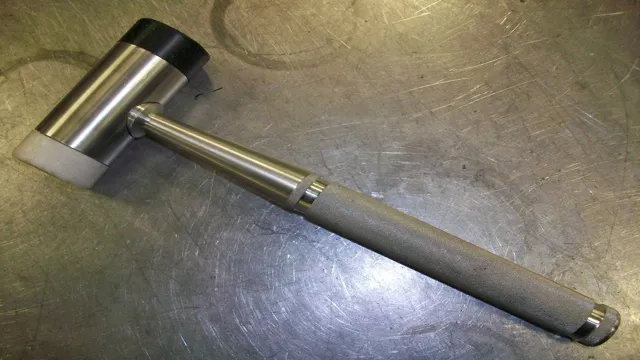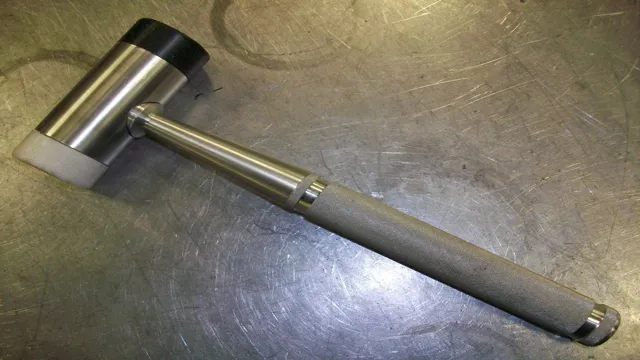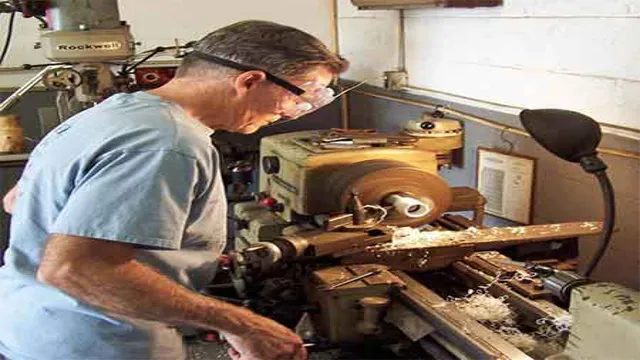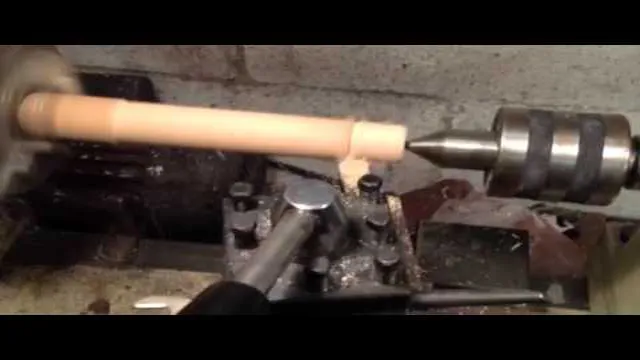How to Lift a Metal Lathe Safely and Easily: Tips and Techniques

Lifting a metal lathe can be an intimidating task, especially for those who haven’t tackled such a monumental job before. If you’re feeling overwhelmed, take a deep breath and remember that with the right tools, technique, and know-how, you can do it! In this blog post, we’ll be sharing some tips and tricks on how to lift a metal lathe safely and efficiently. Whether you need to move it from one workshop to another or just want to reposition it within your current space, we’ve got you covered.
So, let’s get started!
Assess the Weight and Size
When it comes to lifting a metal lathe, assessing the weight and size is crucial. Metal lathes are typically heavy and bulky machinery, which means that moving them requires proper planning and technique. You don’t want to risk injury or damage to the equipment by trying to lift it without fully understanding its dimensions.
Start by checking the weight and dimensions of the lathe and compare it to your own strength and abilities. If it’s too heavy, you may need to enlist the help of others or use specialized lifting equipment like a forklift or crane. It’s also essential to ensure that the path you plan to take is clear of obstacles and that you have enough space to maneuver the lathe.
By taking the time to assess the weight and size of the lathe, you can ensure a safe and successful move.
Evaluate the Weight Capacity of Lifting Equipment
When it comes to lifting equipment, it is essential to assess the weight and size of the load to ensure that the equipment is capable of handling it safely. Knowing the exact weight and dimensions of the load will help determine the appropriate equipment and avoid accidents or damages. The weight capacity of lifting equipment varies, with different machines designed to lift different loads.
Some machines are designed to lift lighter loads, while others can handle heavyweights. It is crucial to check the maximum weight capacity and ensure that the load does not exceed it. Overloading the equipment can lead to dangerous situations, such as tipping or collapsing.
In addition to the weight, the size and shape of the load are also essential factors to consider when assessing the weight capacity of lifting equipment. An oversized or oddly shaped load can put extra strain on the equipment, affecting its stability and increasing the risk of accidents. Therefore, it is necessary to consider the dimensions of the load and ensure that they do not exceed the equipment’s capacity.
In conclusion, evaluating the weight capacity of lifting equipment involves assessing the load’s weight, size, and shape. Knowing these factors will help determine the appropriate equipment for the job and ensure that the equipment is used safely. Always remember to check the maximum weight capacity of the equipment and avoid overloading.
By following these guidelines, accidents and damages can be avoided, and lifting operations can be carried out smoothly and efficiently.
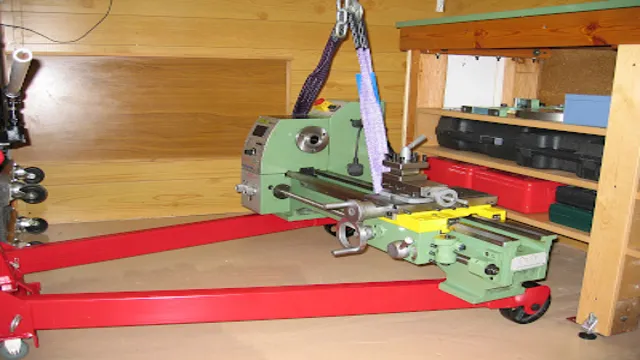
Measure the Size of the Metal Lathe for Clearance
When choosing a metal lathe, it’s important to assess the weight and size to ensure that it will fit in your workspace and be easily maneuvered. Start by measuring the dimensions of the lathe, including the length, width, and height. This will help you determine the clearance needed for the machine to fit comfortably in your shop.
Additionally, consider the weight of the lathe. A heavy machine may require special equipment or additional assistance to move into place. When measuring, keep in mind any obstacles that may interfere with the installation process, such as low ceilings or narrow doorways.
By accurately assessing the size and weight of the metal lathe, you can ensure a smooth installation process and have confidence in the machine’s performance.
Choose the Right Lifting Equipment
If you’re planning on moving or relocating a metal lathe, it’s essential to use the right lifting equipment to prevent any accidents or injuries. One of the first things you should do before lifting a heavy piece of machinery is to check its weight and dimensions to determine the appropriate lifting equipment. Depending on the size, weight, and shape of the lathe, you might need a forklift, crane, or hydraulic jack to lift and move it safely.
Always ensure that you use the proper lifting gear, including straps, chains, and slings, and double-check the load capacity of your equipment before lifting any machinery. If you’re unsure about how to use any of the lifting gear, it’s always best to consult with a professional to avoid any potential accidents. Remember, taking the necessary safety precautions is critical when lifting heavy machinery like a metal lathe.
Consider using a Crane or Forklift for Larger Lathes
If you’re working with larger lathes, consider using a crane or forklift to handle the heavy lifting. It’s essential to choose the right lifting equipment for the job to ensure the safety of everyone involved. When selecting a crane or forklift, it’s essential to consider the weight of your lathe and the working area’s size and shape.
A crane is an excellent choice for larger lathes because it can lift heavy loads with ease. However, cranes require more space to operate, and not all worksites can accommodate them. Forklifts, on the other hand, are more versatile and can work in tighter spaces.
However, they have weight limitations, so it’s crucial to choose a forklift that can handle the weight of your lathe. When choosing the right lifting equipment for your lathe, safety should always be your top priority. Making the right choice can make a world of difference in terms of productivity, efficiency, and safety.
Choose a Heavy-Duty Hand Truck or Pallet Jack for Smaller Lathes
When it comes to smaller lathes, it’s important to choose the right lifting equipment to ensure safe and efficient transportation. A heavy-duty hand truck or pallet jack is typically the best option for smaller lathes, as they offer the necessary support and stability to move machinery with ease. These types of equipment can handle heavier loads and provide greater maneuverability to navigate through tight spaces.
It’s also important to consider the features of each option, such as the weight capacity and ease of use, to ensure that you choose the best fit for your specific needs. Don’t settle for a subpar lifting option that may lead to injury or damage to your machinery – invest in a heavy-duty hand truck or pallet jack for the safest and most efficient transport solution.
Use Lifting Straps or Chains for Added Support
When lifting heavy loads, it’s essential to use the right equipment to ensure your safety and prevent injuries. A pair of lifting straps or chains can provide added support to help you lift more weight with ease. These lifting accessories are designed to distribute the load’s weight more evenly across your arms, reducing the risk of strain or injury.
Choosing the right lifting equipment is crucial to ensure maximum lifting potential, minimizing stress on the body. Lifting straps and chains come in various sizes and materials, so it’s important to choose the appropriate type for your needs. By using lifting straps or chains, you can perform heavy lifting tasks safely and effectively while avoiding unnecessary strain and discomfort.
When dealing with heavy loads, don’t overlook the importance of proper lifting equipment to keep you safe and working efficiently.
Prepare for Lifting
If you’re planning to move a metal lathe, proper preparation is crucial to ensure a safe and successful move. First and foremost, make sure you have the appropriate lifting equipment, such as a forklift or hydraulic lift. Before lifting, it’s also important to clear the area around the lathe, removing any obstacles that could potentially cause accidents.
When lifting the lathe, it’s essential to distribute the weight evenly to prevent any damages. It’s recommended to attach the lifting equipment to the base of the lathe rather than the chuck or tailstock, which could cause the machine to tip over. Additionally, you should secure the lathe to the lifting equipment to prevent movement during transport.
By following these guidelines, you can safely and effectively lift and move a metal lathe.
Clear the Pathway for Safe Transport
If you want to ensure safe transportation of heavy goods, preparing for lifting is a crucial step. Clearing the pathway for transporting the goods to the designated area is essential to avoid any accidents. It is important to make sure that all obstacles are removed so the transporter can easily move through the area without any difficulties.
Furthermore, you should check the weight of the products before lifting to prevent any risks and mishaps during the process. One of the most important steps in preparing for lifting is to ensure that the lifting equipment is in good condition and meets the safety measures. Always use the load capacity specifications of the equipment as a guide when selecting the appropriate lifting tools.
Remember, safety should be a top priority when transporting heavy goods. With a well-prepared plan and the right tools, you can ensure that your transportation process goes smoothly and securely.
Secure the Metal Lathe with Straps or Chains
Securing a metal lathe before lifting it is crucial to ensure the safety of both the machine and the people involved in the lifting process. Straps or chains can be used to secure the lathe. Before strapping or chaining, the metal lathe must be prepared for lifting.
The first step is to ensure that the lathe is placed on a clean and level surface. Then, check the load capacity of the lifting equipment to ensure that it is sufficient to lift the metal lathe safely. It is also important to inspect the straps or chains to ensure that they are in good condition and rated to handle the weight of the metal lathe.
Once the preparation is complete, secure the metal lathe with the straps or chains, making sure that they are tight and will not slip during the lifting process. By taking these precautions, the metal lathe can be safely lifted without the risk of injury or damage to the equipment.
Lift the Metal Lathe Safely
Lifting a metal lathe can be a daunting task, especially if you’re not sure how to do it safely without risking injury or damaging the machine. First and foremost, it’s important to assess the weight and size of the lathe and determine if you’ll need help moving it. If you do, be sure to enlist the help of another person or use a hoist or lift to avoid straining yourself.
When you’re ready to lift the lathe, be sure to position yourself and your partner (if applicable) properly. Use your legs to lift instead of your back, and keep your back straight and core tight to avoid injury. If possible, use lifting straps or a sling to ensure a secure hold on the machine.
Remember to communicate with your partner throughout the process to avoid any mishaps. With these safety tips in mind, you can lift your metal lathe with ease and confidence.
Follow Proper Lifting Techniques
When working with a metal lathe, lifting heavy parts or pieces is often necessary. However, it’s crucial to follow proper lifting techniques to avoid injury and damage to the machine. Before lifting, be sure to assess the weight of the object and determine if you need assistance.
Use your legs, not your back, to lift and maintain a straight posture throughout the process. One metaphor that may be helpful to keep in mind is to imagine your body as a crane, with your legs as the base and your arms as the hook. Engage your core muscles to stabilize your body and prevent strain on your back.
By following these simple tips, you can lift the metal lathe safely and effectively without causing harm to yourself or the machine.
Lift Slowly and Steadily
When it comes to using a metal lathe, it’s important to prioritize safety. One key aspect of using a metal lathe safely is being careful when lifting the machine. You don’t want to risk injuring yourself or damaging the lathe.
The best approach is to lift the lathe slowly and steadily, using proper lifting techniques. This means keeping your back straight, bending at the knees, and utilizing the strength in your legs rather than your back. Additionally, you may want to consider using a lifting aid, such as a crane or hydraulic lift, to make the process easier and safer.
By taking your time and being careful when lifting your metal lathe, you’ll reduce the risk of injury and ensure that your machine remains in good condition for years to come.
Conclusion
In conclusion, lifting a metal lathe is not for the weak or faint of heart. It requires strength, skill, and some creativity. Just like in life, we encounter heavy obstacles that we must overcome.
We cannot simply wish them away or hope for an easy solution. Instead, we must use our ingenuity and resourcefulness to find a way to lift and move forward. So, always be prepared, keep your mind sharp, and remember that with determination and a little bit of elbow grease, you can lift a metal lathe and conquer any challenge that comes your way!”
FAQs
What are some essential tools required to lift a metal lathe?
Forklifts, chain hoists, hydraulic jacks, and pallet jacks are some of the essential tools required to lift a metal lathe safely.
How much weight can a forklift lift and move?
The carrying capacity of a forklift can vary from 3000 pounds to 60,000 pounds. It is important to choose the right size of the forklift according to the weight of the metal lathe.
What precautions should be taken while lifting a metal lathe?
Some of the precautions that should be taken while lifting a metal lathe include checking the weight capacity of the lifting equipment, securing the lathe with slings and straps, and ensuring that all clamps, bolts, and knobs are tightened.
How many people are required to lift a metal lathe?
The number of people required to lift a metal lathe depends on the weight and size of the lathe. It is always recommended to follow the manufacturer’s guidelines and hire a professional team to ensure safety.
What are the different types of slings that can be used to lift a metal lathe?
Nylon, chain, wire rope, and polyester slings can be used to lift a metal lathe. The choice of the sling depends on the weight and shape of the lathe.
What are the common mistakes to avoid while lifting a metal lathe?
Some common mistakes to avoid while lifting a metal lathe are exceeding the weight capacity of the lifting equipment, using damaged slings or straps, and not securing the lathe properly.
How to ensure a stable base for lifting a metal lathe?
Before lifting a metal lathe, it is important to ensure a stable base by using wooden blocks or leveling jacks. This will prevent the lathe from tipping over during the lifting process.

